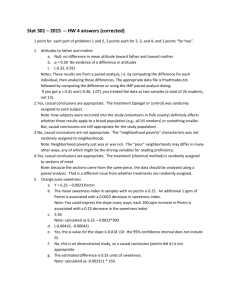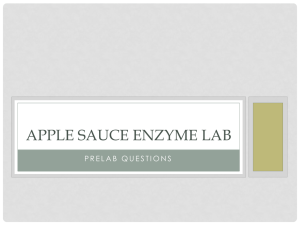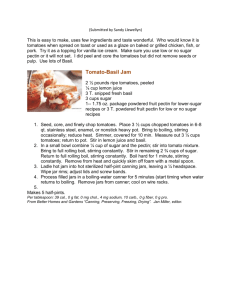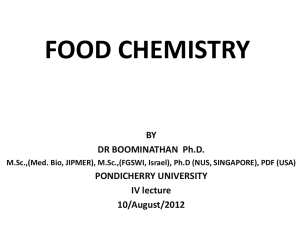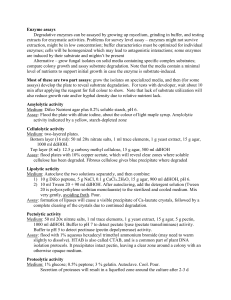Biochemistry of Fruits and Vegetables
advertisement
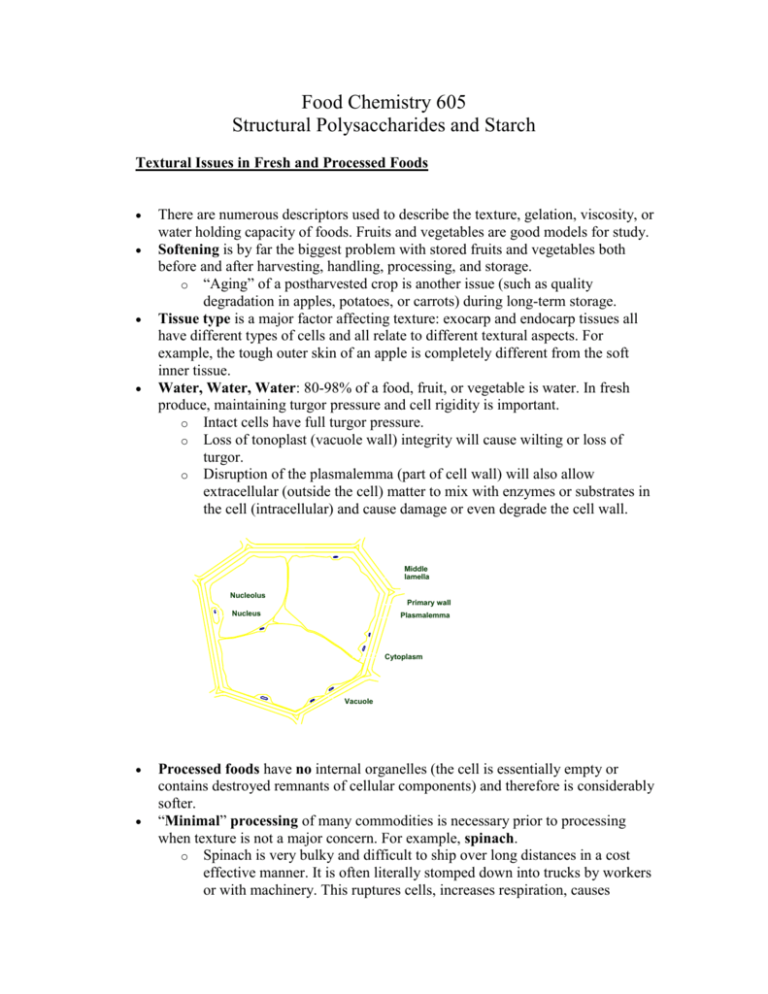
Food Chemistry 605 Structural Polysaccharides and Starch Textural Issues in Fresh and Processed Foods There are numerous descriptors used to describe the texture, gelation, viscosity, or water holding capacity of foods. Fruits and vegetables are good models for study. Softening is by far the biggest problem with stored fruits and vegetables both before and after harvesting, handling, processing, and storage. o “Aging” of a postharvested crop is another issue (such as quality degradation in apples, potatoes, or carrots) during long-term storage. Tissue type is a major factor affecting texture: exocarp and endocarp tissues all have different types of cells and all relate to different textural aspects. For example, the tough outer skin of an apple is completely different from the soft inner tissue. Water, Water, Water: 80-98% of a food, fruit, or vegetable is water. In fresh produce, maintaining turgor pressure and cell rigidity is important. o Intact cells have full turgor pressure. o Loss of tonoplast (vacuole wall) integrity will cause wilting or loss of turgor. o Disruption of the plasmalemma (part of cell wall) will also allow extracellular (outside the cell) matter to mix with enzymes or substrates in the cell (intracellular) and cause damage or even degrade the cell wall. Middle lamella Nucleolus Primary wall Nucleus Plasmalemma Cytoplasm Vacuole Processed foods have no internal organelles (the cell is essentially empty or contains destroyed remnants of cellular components) and therefore is considerably softer. “Minimal” processing of many commodities is necessary prior to processing when texture is not a major concern. For example, spinach. o Spinach is very bulky and difficult to ship over long distances in a cost effective manner. It is often literally stomped down into trucks by workers or with machinery. This ruptures cells, increases respiration, causes bacterial contamination, and makes a big mess. Directly from a field, spinach will last for only ~12 hrs without cooling before it is degraded beyond use (very fast!!). Chill sensitive plants have more textural issues than chill insensitive plants due to membrane disruption. Freeze-thaw cycles: Commodity specific, but membrane damage/rupturing is considerably greater with a slow freeze (large ice crystals) compared to a rapid freeze. Cryoprotective agents can be used to protect the cells if necessary; examples include sugar or salt solutions (increases the osmotic pressure). The high extent of sweetness or saltiness makes this a limited process (candied apples) CELL WALL COMPOSITION Pectic substances hold (glue) cells together (and between cells as well). In higher plants pectin dominates, in lower plants it is alginates; so the two are synonymous. The cell wall is composed of three main pectic components: the middle lamella, primary cell wall, and secondary cell wall. “Pectic substances” are composed primarily of: o Polymerized galacturonic acid (most abundant component) o Glucose (from cellulose) o Sugar alcohols (from hemicellulose) The ML and primary cell wall are composed primarily of pectic substances and are the most important components influencing texture in plants. Extractions of pectin for analysis should distinguish between the cell wall and ML tissues, even though both are mostly pectin, they each contribute differently to texture. Other components include: o Cellulose: from ML to inside of cell (more inside cell than in outer cell layers). Cellulose is ß-1,4 linked glucose. o Hemicellulose: from inner cell to ML (more in outside of cellular layers than inside layers). Hemicellulose is similar to cellulose (glucose polymers) with additional sugars and sugar alcohols linked as well; such as galactose, arabinose, xylose, glucose, and rhamnose. These form side chains known correspondingly as glucans, xylans, galactans, and galacturans. o Lignin: found in similar places as hemicellulose. Diferulic acid polymers and other complex alcohols. Pectin is a methylated alpha 1,4 linked polygalacturonic acid chain. An example of a typical pectin is a rhamnogalactronan, which is composed of ~98% galacturonic acid and ~2% rhamanose that gives “kinks” in the pectin chain (linked alpha 1,2). o Adding: Galacturonic acid + SAM =>transferase=> methylated pectin o Removing: methylated pectin =>methylesterase=> galacturonic acid with free COOH groups attached (important ionic binding site). o Generally, once a pectin has been demethylated it will not re-methylate. o Degree of Esterification (DE): 0-100% of available carboxylic acid groups have a methyl ester attached (important for texture and food quality) o At most, a 100% methylated pectin can have 16.32% methyl groups by weight. o Demethylated pectin is important for textural properties as the carboxylate can bind mono-, di-, and trivalent cations effectively (Al, Ca, Mg, Na, K). This type of cross-linking serves to improve texture through intermolecular crosslinking (metal inside the polymer binds with a free binding site on a different/adjacent pectin chain) or intramolecular crosslinking (a single pectin chain binds or coils with itself linked via the metal ion). o %DE and depolymerization of pectin chains all influence texture. Pectin hydrolysis (acid or base) and transelimination reactions by pectin methyl esterase (PME) all cause softening and reduction in quality of fresh fruits and vegetables. Important processing aid in juices, however. Pectin depolymerization by pectin-active enzymes is also a major textural issue. In ripening fruit, these enzymes are highly desirable but in mature fruit it is a leading cause of product rejection (too soft = poor quality). The major depolymerization enzyme responsible for texture changes is polygalacturonase (PG). Pectin-active enzymes o Endo-PG is the most influential enzyme on fruit texture (less so on vegetables). The “endo” is a random cleavage mechanism that can rapidly break down pectin and cause rapid tissue softening (or ripening). o Exo-PG is different in that it depolymerizes only the end of the galacturonic chain, therefore a little slower. Mealy Apples: contain mostly exo-PG therefore they can be stored for long periods of time without softening. Apples get “mealy” after long-term storage and action of the PG begins to create “loosely” attached cells…resulting in very poor texture. Freestone (aka Melting Flesh) vs. Clingstone (aka Non-Melting Flesh) Peaches: Clingstone peaches have primarily exo-PG, therefore their texture is much tougher and are typically used for processing (not very juicy due to water binding by the pectin). However, some people think that clingstone peaches taste better, and so these are also sold as fresh fruit. Freestone peaches are used almost exclusively for the fresh fruit market and contain mostly endo-PG. Therefore, they get softer much faster, but the stone comes loose very easily from the flesh and is what most people want. Wooly Peaches: When stone fruits are chill injured; their texture becomes more like that of a clingstone (lack of juiciness). However, since clingstone peaches can’t synthesize endo-PG there is no depolymerization of pectin and the result is a fruit that can’t soften and the resulting texture is a “wooly” or dry mouth feel. o No demethylation No endo-PG No softening No pectin break-down Large amounts of water absorbed by the pectin= “dry” Enzymatic vs Alkaline Degradation of Pectin 3 reaction mechanisms here: two are chemically altering and the other is just a pectin chain breaker. Pectin lyase = transeliminase. The pectin chain MUST be methylated for this enzyme to operate and will break a pectin chain to form a double bond between C4 and C5. Often referred to as ß-transelimination. This is a chemical alteration; the double bond can be detected by UV as a measurement tool for the enzyme action. Pectin lyase is typically not found in nature and is used as a food processing aid from bacterial preparations. Alkaline hydrolysis = same end product as pectin lyase (broken pectin chain and a double bond from methylated pectin chains). Often referred to as a ß-elimination reaction, the glycosidic linkage of the pectin chain that is in the ßposition to the ester carbonyl group is cleaved to give that characteristic C4-C5 double bond. Foods such as beans can actually be “cooked” by raising the pH and softening by ßelimination (ie. Beans). The breakdown of the pectin chain will make the pectin more soluble and thus alter texture. Dry beans are often soaked in baking soda to help them cook faster (and to remove non-digestable carbohydrates). Polygalacturonase (PG) = requires a demethylated pectin to react (often a PME pre-treatment is employed) and no double bond is formed. Pectin chain is simply broken into smaller, more soluble pieces without much chemical alteration. Since PG requires a demethylated pectin chain, the addition of a metal ions can actually inhibit the enzyme by chelating to the COO- site needed for PG action Pectin Methylesterase (PME) removes a methyl ester (-OCH3), which is essentially methanol. Aka: pectin demethyloxidase, pectin esterase, pectin pectylesterase Strong acids can demethylated pectin but alkali conditions work much better (pH >7) and with higher temperatures. The key is demethylation without depolymerization for quantitative measure of methanol in pectin, thus determining extent of methylation. PME is ubiquitous in plant systems and is the most common demethylation reaction in higher plants. A common reaction involving PME is known as a transacylation reaction. Here, unlike many reactions in food chemistry, the action of PME results in a product that is larger than the individual reactions. Pectin-CO-OCH3 + Pectin-CO-OCH3 =>PME=> PectinCO-O-Pectin The reactant is even larger when metal chelation occurs. PME is activated by numerous factors: Ruptures of cell membranes allowing ions from the vacuole to enter the cytoplasm and activate the enzyme Temperature. 50-70C will also rupture cell membranes. Enzyme is inactivated >70C. pH. Generally, PME is more active at lower pH than high pH (ie. Fully active in juice systems like orange juice). Physical damage. No explanation needed. High pressure (>100 Mpa). In high pressure processing of some intact produce will actually increase in firmness due to PME activation and metal binding. High ionic strength. Flow of ions to the surface of a cell wall will rupture the cell membrane and stimulate the enzyme. High degree of esterification (High Methoxy): decreases action of PG, increases ß-elimination, restricts pectin cross-linking, favors gel formation with high solids content (high sugar for jam and jelly) Low degree of esterificaiton (Low Methoxy): increased action with PG, decreased ß-elimination, promotes pectin cross-linking with metals (low solids for jams and jellies and inhibits PG). A developed disorder with beans is known as “hard to cook” or “hard to soak” beans. When dry beans are exposed to high humidity and high temperature conditions during storage PME can be activated. The demethylation results in metal cross-linking, inhibiting ß-elimination and preventing cells from separating and cooking. In some cases, these beans won’t completely soften no matter how long you cook them!! Another developed disorder is “hardcore” in sweet potatoes. Generally associated with chill injury, the breakdown in cell permeability can stimulate PME. Typically, the taters are exposed to cold temps first (chill injury) followed by normal storage temperatures. The normal storage temperature enhances demethylation, promotes metal ion binding, hinders ß-elimination, and results in a sweet potato that will not soften in the middle upon cooking. PME can be a beneficial processing aid, or a curse to your process, depending on perspective. Pre-heating for increased firmness: Blanching fruits and vegetables typically softens tissues and facilitates addional processing; however, if only a very mild blanch is used (thus the term “preheating”) then PME can actually be activated, demethylates pectin, inhibits ß-elimination, and results in a firmer processed product. (see “landmark” paper by Bartolome and Hoff, 1972). Maximum PME activity observed between 60-70C for potatoes; the low DE (low methoxy pectin) was an indication that methanol was being liberated and metal cross-linking was occurring. In theory, something like a potato could be pre-heated to an extent where it would never soften during cooking. Hallmark paper from Bartolome and Hoff: Potatoes preheated at different times No texture differences after preheating Taters cooked 60-70C preheat temps had best firmness (time dependent) ~60C membrane rupture occurred Calcium bound to starch was released Mg and K caused increase in ionic strength to further activate PME Cross-linking of pectin after starch gel. Missed point in paper: Authors forgot about ßelimination that would have occurred during cooking. Tomato Sauce: Formation of gels in the tomato sauce used to be a big problem. Also, the lack of a gel forming. Residual PME in the crushed tomatoes was demethylating pectin and forming low DE pectin that would cross-link with calcium. Or…residual PG was present that would start to break down pectin chains, liquefying the product. Issues with both problems could have been from naturally occurring enzymes in the tomatoes or from bacterial contamination on the tomatoes (lets face it, the best tomatoes are sold fresh and the rest gets processes….mico mess). Solution to both issues: more heat. Especially in the case of micro-derived PME and PG since these enzyme isoforms tend to be more heat resistant than those found naturally in tomatoes. Orange Juice: One of the few “cloudy” juices that are consumed (apple cider is another). Juice must be quickly heat treated to inactivate PME since demethylated pectin will rapidly chelate calcium and form insoluble calcium pectates in the juice….thus “clarifying” the juice. Pectin should be kept as soluble as possible. With other juice types (ie. Apple) a clear juice is highly desirable. Cellulose: ß-1,4 linked glucose. Important for textural properties of fruits an veggies, but not as important as pectin in higher plants.\ Cotton ~ 90%; Wood ~ 50%; Plants ~30% (dry weights) o Crystalline structure: glucose polymers stacked in layers on each other o Callose is a form of cellulose and is ß-1,3 linked glucose that forms in response to stress as a wound healing process. o H-bonding within strands of glucose can be altered, but the severity of food processing operation is typically not enough appreciably alter it. o Cellulose is not considered an energy reserve for glucose utilization. o Cellulose is not typically assocated with tissue softening in fruits and veggies, but influences texture by it presence (cellulase enzymes are not concentrated or active in edible plants.) Starch also influences texture: 70-80% of the energy reserves of a plant are starch. In human diets, >50% of our caloric intake is from starch (rice, taters, legumes, corn, roots, tubers, cassava, taro, etc). o Amylose (alpha 1,4 glucose) with a typical chain >200 units o Amylopectin (alpha 1,4 and 1,6 glucose), typical chain >2,000 units o Approx. 75% of starch in plants is amylopectin (tassel on a string shape). o Amylographs (Brabender) measure the viscosity of starch slurry over a time/temperature range. 3-stage process: starch swelling (high viscosity), mechanical breakdown (decreased viscosity), and finally gelation (increased viscosity). o Texture of a high starch fruit or vegetable (think potatoes here) is altered by heating. Starch goes from a nice, neat crystalline (H-bonded) from to an amorphous “mass” that will re-form H-bonding upon cooling. Later, a “staling” process or retrogradation occurs, where the starch attempts to return to its original crystalline form. Starch will never return to its original state, but the H-bonding is very similar. o pH influences starch and its viscosity. Every notice that high acid foods don’t have any starch (or very little). Acid hydrolysis occurs in native starch (decreasing viscosity); a starch must be modified to resist acid for use in high acid processed foods. Amylases: 4 main types. Native starch is typically resistant to amylase action, therefore a pre-galatinazation step is often needed to break the H-bonded crystalline structure. o ß-amylase: acts from the non-reducing end of the starch (amylose or amylopectin) and acts only on alpha 1,4 linkages; breaking 2 units at a time to form maltose. Since it starts at one end and starts “chewing” two sugars at a time, it is slow and can’t get past a branching point. o Alpha-amylase: will break starch with a random cleavage action all any and all points in the starch chain except for branching points (alpha 1,6). This is obviously a faster, more efficient enzyme and is optimal for rapid viscosity changes and hydrolysis of starch. o Glucoamylase: this exo-amlyase also acts from the non-reducing end of the starch, but only cleaves 1 glucose molecule at a time. It will break both alpha 1,4 and 1,6 bonds, but it must cleave 1 glucose at a time until it gets to the branching point. Slow enzyme, but works well when a mixture of enzymes is used. o Pullulanase: randomly cleaves alpha 1,6 bonds. Known as the “debranching enzyme”, it also works well in mixed enzyme sytems. Sweet potatoes (purees) are a good example of where amylases (natural and exogenous) have been successfully used as a processing aid. o Sweet potatoes have significant sucrose reserves, but most carbohydrates are locked into starch. Amylase (ß and alpha) are naturally present and must be activated for maximal sweetness. o ß-amylase is relatively heat labile (inactivating at 75-85C) while alphaamylase is more heat stable (up to 100C for some isoforms). o The key to thermally processed sweet potato puree is a slow “come up time” (CUT) so that sufficient starch hydrolysis can occur. This type of process was perfected and applied to the baby food industry (Gerber). Once the slow heating process has progressed sufficiently (10-30 min) during the retort process, the process temp is increased and processing complete. Another trick of the process: add “cured” sweet potatos (or puree) to fresh, raw puree. The “curing” process is similar to a pre-heating step and contains enzymes at their maximal activity…out looking for more starch to break down. Also, commercially available enzyme preparations can be added for a more consistent product. o Without sufficient amylase activity, a strong gel can form in cans and jars from starch retrogradation (not a good thing, and poor eating quality). o ß-amylase is closely related to the starch, evenly distributed in the potato. o Alpha-amylase is associated with the periderm, may even be removed by peeling. o For home application: Cooking sweet potatoes in the microwave is too fast, boiling is better, and the dry (slow) heat of a conventional oven is best for maximal free sugar release.
